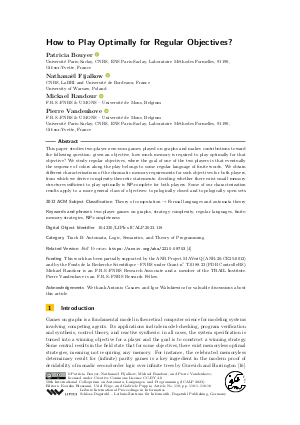@InProceedings{bouyer_et_al:LIPIcs.ICALP.2023.118,
author = {Bouyer, Patricia and Fijalkow, Nathana\"{e}l and Randour, Mickael and Vandenhove, Pierre},
title = {{How to Play Optimally for Regular Objectives?}},
booktitle = {50th International Colloquium on Automata, Languages, and Programming (ICALP 2023)},
pages = {118:1--118:18},
series = {Leibniz International Proceedings in Informatics (LIPIcs)},
ISBN = {978-3-95977-278-5},
ISSN = {1868-8969},
year = {2023},
volume = {261},
editor = {Etessami, Kousha and Feige, Uriel and Puppis, Gabriele},
publisher = {Schloss Dagstuhl -- Leibniz-Zentrum f{\"u}r Informatik},
address = {Dagstuhl, Germany},
URL = {https://drops.dagstuhl.de/entities/document/10.4230/LIPIcs.ICALP.2023.118},
URN = {urn:nbn:de:0030-drops-181700},
doi = {10.4230/LIPIcs.ICALP.2023.118},
annote = {Keywords: two-player games on graphs, strategy complexity, regular languages, finite-memory strategies, NP-completeness}
}

 Creative Commons Attribution 4.0 International license
Creative Commons Attribution 4.0 International license

